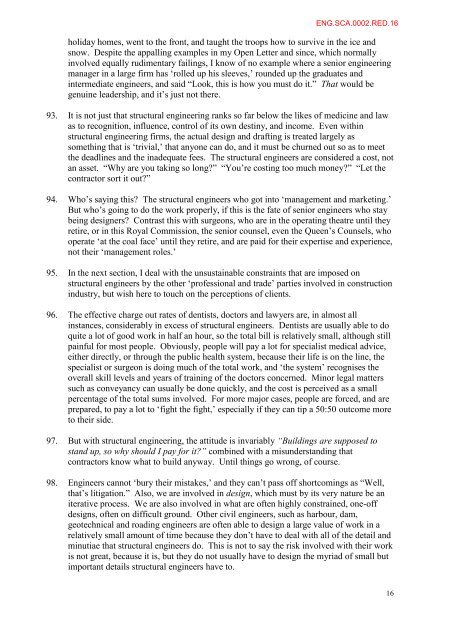John Scarry Engineering - Canterbury Earthquakes Royal ...
John Scarry Engineering - Canterbury Earthquakes Royal ...
John Scarry Engineering - Canterbury Earthquakes Royal ...
Create successful ePaper yourself
Turn your PDF publications into a flip-book with our unique Google optimized e-Paper software.
ENG.SCA.0002.RED.16<br />
holiday homes, went to the front, and taught the troops how to survive in the ice and<br />
snow. Despite the appalling examples in my Open Letter and since, which normally<br />
involved equally rudimentary failings, I know of no example where a senior engineering<br />
manager in a large firm has ‘rolled up his sleeves,’ rounded up the graduates and<br />
intermediate engineers, and said “Look, this is how you must do it.” That would be<br />
genuine leadership, and it’s just not there.<br />
93. It is not just that structural engineering ranks so far below the likes of medicine and law<br />
as to recognition, influence, control of its own destiny, and income. Even within<br />
structural engineering firms, the actual design and drafting is treated largely as<br />
something that is ‘trivial,’ that anyone can do, and it must be churned out so as to meet<br />
the deadlines and the inadequate fees. The structural engineers are considered a cost, not<br />
an asset. “Why are you taking so long?” “You’re costing too much money?” “Let the<br />
contractor sort it out?”<br />
94. Who’s saying this? The structural engineers who got into ‘management and marketing.’<br />
But who’s going to do the work properly, if this is the fate of senior engineers who stay<br />
being designers? Contrast this with surgeons, who are in the operating theatre until they<br />
retire, or in this <strong>Royal</strong> Commission, the senior counsel, even the Queen’s Counsels, who<br />
operate ‘at the coal face’ until they retire, and are paid for their expertise and experience,<br />
not their ‘management roles.’<br />
95. In the next section, I deal with the unsustainable constraints that are imposed on<br />
structural engineers by the other ‘professional and trade’ parties involved in construction<br />
industry, but wish here to touch on the perceptions of clients.<br />
96. The effective charge out rates of dentists, doctors and lawyers are, in almost all<br />
instances, considerably in excess of structural engineers. Dentists are usually able to do<br />
quite a lot of good work in half an hour, so the total bill is relatively small, although still<br />
painful for most people. Obviously, people will pay a lot for specialist medical advice,<br />
either directly, or through the public health system, because their life is on the line, the<br />
specialist or surgeon is doing much of the total work, and ‘the system’ recognises the<br />
overall skill levels and years of training of the doctors concerned. Minor legal matters<br />
such as conveyancy can usually be done quickly, and the cost is perceived as a small<br />
percentage of the total sums involved. For more major cases, people are forced, and are<br />
prepared, to pay a lot to ‘fight the fight,’ especially if they can tip a 50:50 outcome more<br />
to their side.<br />
97. But with structural engineering, the attitude is invariably “Buildings are supposed to<br />
stand up, so why should I pay for it?” combined with a misunderstanding that<br />
contractors know what to build anyway. Until things go wrong, of course.<br />
98. Engineers cannot ‘bury their mistakes,’ and they can’t pass off shortcomings as “Well,<br />
that’s litigation.” Also, we are involved in design, which must by its very nature be an<br />
iterative process. We are also involved in what are often highly constrained, one-off<br />
designs, often on difficult ground. Other civil engineers, such as harbour, dam,<br />
geotechnical and roading engineers are often able to design a large value of work in a<br />
relatively small amount of time because they don’t have to deal with all of the detail and<br />
minutiae that structural engineers do. This is not to say the risk involved with their work<br />
is not great, because it is, but they do not usually have to design the myriad of small but<br />
important details structural engineers have to.<br />
16




